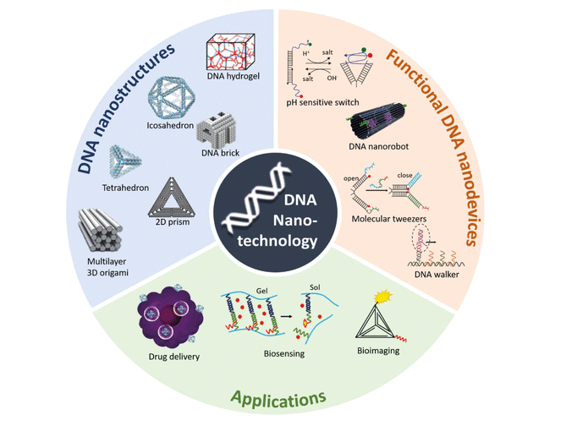Video Article Open Access
DNA Nanotechnology Based Emerging Technologies for Biological and Biomedical Applications
Dhiraj Bhatia
Biological Engineering Discipline, Indian Institute of Technology Gandhinagar, IIT Gandhinagar, Near Palaj Village, Gandhinagar 382355, Gujarat, India
Vid. Proc. Adv. Mater., Volume 3, Article ID 2206276 (2022)
DOI: 10.5185/vpoam.2021.06276
Publication Date (Web): 07 Sep 2022
Copyright © IAAM
Graphical Abstract

Abstract
My laboratory ask how nanometer-sized biomolecules transmit and integrate information across much larger length scales of the orders of cells and tissues. We seek to explore how collections of macromolecules work together to establish a common functional system like cellular pathways, organelles, living cells and further into tissues, organs and entire organisms. Different biomolecules establish long-range orders in living systems by self-assembling into much larger structures, such as molecular complexes, membranes, and cytoskeletal organelles, intra- and inter-cellular contacts, and long range contacts. The main theme of our lab will be understand the assembly principles of biological systems and the roles they play in living cells, tissues and full organisms...and further developing technologies to modulate the same. To address these problems, we adapt multidisciplinary, bottom-up approach using DNA nanotechnology. DNA has immense potential to arrange the matter at nanoscale with extreme robustness and spatial specificity. The compatibility of DNA to interface with other biomolecules like proteins, carbohydrates, lipids, small molecules make DNA a natural choice of material for bottom-up self-assembly. Thus, we will merge the complex programmability of DNA nanotechnology with the structural and functional diversity of other biomolecules. Our interdisciplinary research, along with national and international collaborations with experts, will leverage expertise from chemistry, nanotechnology, biophysics, biology, engineering, and medicine. The overarching goal of the my team would be to translate laboratory findings into the development of new therapeutic strategies.
Keywords
Structural DNA nanotechnology, 3D cages, monofunctionalized quantum dots, single particle tracking.
Acknowledgement
DB thanks SERB, GoI for Ramanujan Fellowship, IITGN, for the startup grant, and DBT-EMR, Gujcost-DST, GSBTM and BRNS-BARC for research grants. Imaging facilities of CIF at IIT Gandhinagar are acknowledged.
References
- Pravin Hivare, Anjali Rajwar, Sharad Gupta* and Dhiraj Bhatia*; Spatio-temporal dynamics of endocytic pathways adapted by small DNA nanocages in model neuroblastoma cells derived differentiated neurons, ACS Applied Biomaterials, https://doi.org/10.1021/acsabm.0c016682.
- Pravin Hivare, Chinmaya Panda, Sharad Gupta* and Dhiraj Bhatia*; Programmable DNA nanodevices for applications in neuroscience, ACS Chem Neuroscience, https://doi.org/10.1021/acschemneuro.0c007233.
- Udisha Singh, Vinod Morya, Arun Richard Chandrasekaran, Bhaskar Datta, Chinmay Ghoroi, Dhiraj Bhatia*; DNA Functionalized Nanoparticles for Targeted Biosensing AND Biological Applications, ACS Omega, 2020, 10.1021/acsomega.0c03656.
- Anjali Rajwar#, Sumit Kharbanda#, Arun Richard Chandrasekaran, Sharad Gupta, Dhiraj Bhatia*, Designer, Programmable 3D DNA nanodevices to probe biological systems, ACS Applied Biomaterials, 2020, 3, 11, 7265-7277.
- Vinod Morya#, Shanka Walia#, Biman Mandal, Chinmay Ghoroi, Dhiraj Bhatia*, Functional DNA Based hydrogels: Development, Properties & Biological Applications, ACS Biomaterials Science and Engineering, 2020, 6 (11), 6021-6035.
Biography
Dhiraj Bhatia obtained his PhD from NCBS-TIFR in Bangalore, India in DNA Nanotechnology. Post PhD he went to Curie Institute in Paris to join the team of Ludger Johannes initially as Curie fellow and later as HFSP long-term fellow where he learnt the cellular and biological applications of DNA nanodevices. In 2018, he moved to India to start his own laboratory at Indian Institute of Technology Gandhinagar where he is an Assistant Professor and Ramanujan fellow. His lab focusses on translational aspects of DNA nanotechnology to develop tools to program biological systems and having biomedical applications.
Video Proceedings of Advanced Materials

Upcoming Congress



